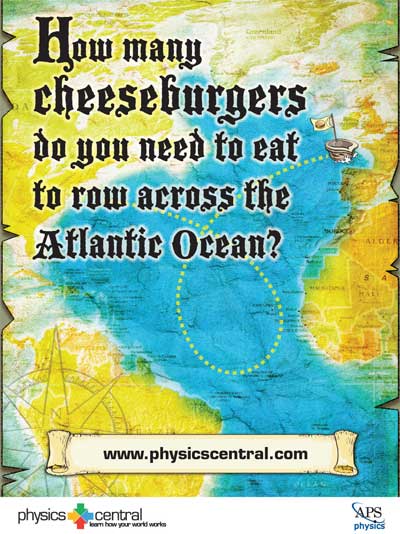How many cheeseburgers do you need to eat to row across the Atlantic Ocean?
“ ‘We’ll see you in France or we’ll see you in heaven!’ cried Harbo and Samuelsen out on the bay.” So begins Jerry Bryant’s not-so-famous song about the first two men to row across the Atlantic Ocean. In 1896 with no help from modern day technologies such as freeze-dried food, GPS navigation systems, radios, flashlights, nylon or even aluminum the two men rowed the 3200 miles from Brooklyn, NY to Le Havre, France. So what does this have to do with physics, or cheeseburgers?
It is all about energy conversion. Energy in food, from oranges to Big Macs, is measured in the familiar calorie. This is a unit of energy just like Joules or horsepower. Energy is always conserved; it is neither created nor destroyed. So when you eat a jelly donut, the energy from the donut has a few places it can go. Your body could turn it in to heat energy to keep your body temperature at a toasty 98.6 degrees. It could be transferred into “kinetic energy” which is energy of motion to do things like aerobics class or chasing down a missed bus. If you don’t use the energy it is stored as fat. This type of stored energy is called “potential energy.” Instead of saying you have a few extra pounds, you can say you are potentially energetic!
George Harbo and Frank Samuelsen did not in fact eat cheeseburgers, the Whopper wasn’t introduced until 1957, but if they did, how many would they have needed to carry with them? To figure this out, we need to know how much energy the two men burned and how much energy is in the average cheeseburger. Ocean rowing with modern day technology burns about 700 calories an hour. With 1896 technology, this number is probably higher, but let’s just assume 700 calories. According to Mr. Bryant, each man rowed 18 hours a day. Multiplying 18 by 700, each man burned 12,600 calories a day. To put that in perspective, that is the energy equivalent of running 5 marathons. Wow! It took them a total of 55 days to make the crossing. This means that they burned about 690,000 calories each. 55 days may seem like a long time to be out at sea, but it took 5 people and 114 years to break their record. To this day, they still hold the record for a two-man boat crossing.
According to the Burger King nutrition information website, a Whopper has 670 calories and according to McDonalds a Big Mac has 576 calories. Big Macs are more popular so that will be the cheeseburger of choice for this calculation. To find out about how many it would take, we need to divide 690,000 by 576. Rounding up, this gives us 1,200 cheeseburgers per man. Total, it would have taken the energy in 2,400 cheeseburgers to get these young adventurers across the sea.
But what if the two were watching their boyish figures and decided to go with apples? An apple has about 100 calories. They would have had to pack a total of 13,800 apples. This is one time a cheeseburger might be better for you than an apple.
Another question to ask is how much cheeseburger weight would they be carrying? The average Big Mac weighs about half a pound. So they would have to carry 1,200 cheeseburger pounds. That is about the weight of a smart car. It’s hard enough to imagine rowing a boat that far, but even harder to imagine doing it while towing a smart car across the sea!
In the closing words of Jerry:
“So those of you listening who yearn for adventure Like Harbo and Samuelson so long ago
Like them be prepared for the task you are facing
They were not only brave but, by God! they could row!”
And eat!












